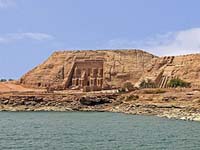Abu Simbel
While the pyramids of Giza are perhaps the most recognizable artifacts of the ancient Egyptian world, following closely behind are the Abu Simbel temples in Southern Egypt, commissioned over 3,000 years ago by Pharaoh Ramses II.
Location
The Temples at Abu Simbel are located in Southern Egypt, at the second cataract of the Nile, close to the Sudanese border. Ramses II chose the site because it was already sacred to Hathor, goddess of motherhood, joy and love. This act strengthened his divinity in the eyes of the ancient Egyptians. It encouraged them to believe that he, too, was a god.

© Héctor de Pereda - The two temples at Abu Simbel
History
The history of the Abu Simbel temples begins with the twenty year effort to build these impressive structures, along with four other rock temples built in Nubia during the reign of Ramses II. The construction of Abu Simbel started around 1244 BC and was finished around 1224 BC.
Many scholars believe that the two temples of Abu Simbel were an act of ego, pride and love on the side of Ramses II. He ordered these temples built to:
- Commemorate his victory at the Battle of Kadesh. To represent the battle, the base of the temple was carved with figures of bound captives.
- Intimidate Egypt's neighbors, the Nubians. It was Ramses' way of trying to make an impression upon Egypt's neighbors, as well as to force Egypt's religion upon these neighbors.
- Honor Nefertari: The Small Temple is a monument to his most beloved queen (out of his many wives), Nefertari. It is also dedicated to the ancient Egyptian goddess Hathor.
- Honor himself: The Great Temple Ramses had built to honor himself, dedicating it to the god Re-Horakhty.
The Great Temple
In ancient times, the Great Temple was known as “The Temple of Ramesses-Meryamun,” which means Ramses, beloved by Amun. It stands 30m (98ft) tall and 35 (115ft) long. The facade of this structure, the Great Temple of Abu Simbel, is 35 meters (115 feet) long and a full 30 meters (98 feet) high.
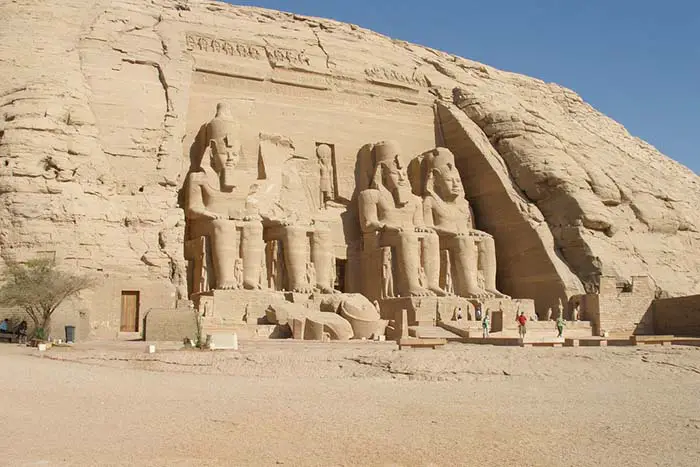
© Vyacheslav Argenberg - Abu Simbel Great Temple
The entrance to the large temple of Abu Simbel is crowned by a carving of Ramses worshiping the falcon-headed god Re-Horakhty, usually referred to simply as Ra. Flanking the entrance are four seated colossal figures, each a towering 20 meters (65 feet) tall. Each of these large figures is a depiction of Ramses II, seated on his thrown, wearing his double crown. Around the figure’s knees there are small carvings of some of his wives and children. Beneath the colossi there are smaller figures that depict Ramses II and his conquered enemies including the Libyans, the Nubians and the Hittites. There are other statues that represent Ramses II’s family members as well as gods of protection.
Inside, the temple has a triangular layout, with rooms decreasing in size as one progresses into the temple; the rooms are filled with engravings of Ramses II and his beloved wife, Nefertari, paying homage to the gods.
Layout
The interior begins with an atrium consisting of eight pillars. One these pillars, Ramses II is depicted in disguise as the god Osiris. Hieroglyphs and images in this atrium depict in grand detail the king’s victory at the Battle of Kadesh.
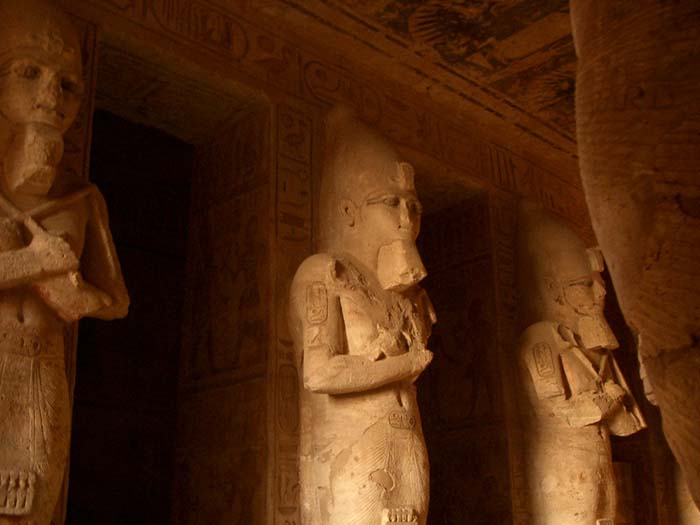
© Paul Nendick - Abu Simbel - Hypostyle Hall of the Great Temple
Beyond the first atrium, a second atrium opens up with four pillars decorated with images showing Ramses II embracing various gods. Beyond the second atrium is the inner sanctuary where statues of Ra, Amun, Ptah and Ramses II are all seated.
The Great Temple was constructed keeping in mind the position of the sun on February 22 and October 22. On these days, sunlight penetrates 55 meters (180 feet) into the inner sanctuary to illuminate the statues along the back wall. Only Ptah, the god of the Underworld, remains in darkness all year round. Why those specific dates were chosen remains a mystery and some believe they might represent Ramses II’s birthday or his coronation.

© Shelby Root - Illuminated back wall of the inner sanctuary
The Small Temple
The Small Temple, built for Queen Nefertari, marks the second time a ruler dedicated a temple to his wife (the first was built by Akhenaten for Nefertiti). It was also the first time that the statue of the wife, Nefertari in this case, was carved the same size as the image of the Pharaoh himself, which is significant in revealing how Ramses II felt about his beloved queen. Usually, the wives statues never measured higher than the Pharaoh’s knees, but Nefertari’s statues was a full 10 meters (32 feet) high.

© superblinkymac - The Small Temple at Abu Simbel
Nefertari’s temple is also aligned to the east. It is about 28 meters (92 feet) long by 12 meters (40 feet) high. The entrance is marked by six colossal figures. There are four figures of Ramses himself and two of Queen Nefertari. Along with the six colossi stand smaller statues that present Ramses’ and Nefertari’s children.
Just inside the entrance sits a large hall, supported by six pillars, each carved with the head of Hathor, as well as scenes showing the King and Queen making offerings to various other Egyptian gods. On the inner room’s back wall, reliefs show Nefertari being crowned by Isis and Hathor.
The interior of the Small Temple is not as complex as the Great Temple. At the end of the large hall there is a doorway, leading to another room decorated with scenes of Ramses II and Nefertari with various gods. Further rooms illustrate similar Egyptian scenes.
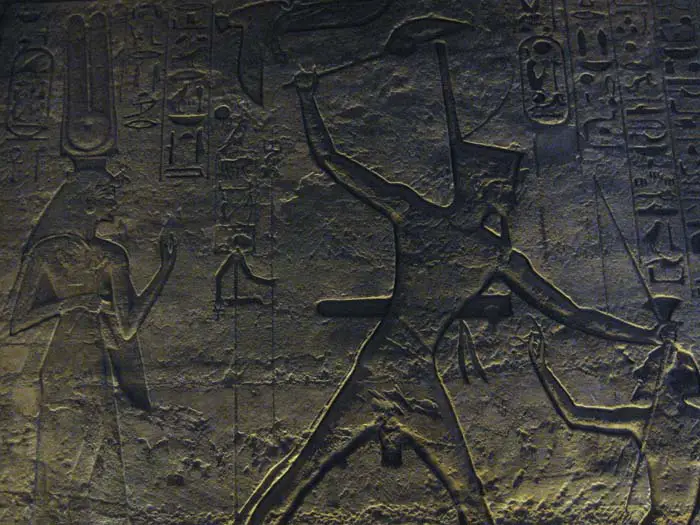
© isawnyu - Relief in the Small Temple at Abu Simbel, depicting Nefertari (left) and Ramses II killing an enemy
Discovery of Abu Simbel
Over time, the temples stopped being used, eventually becoming covered by the dessert sand. By the 6th century BC, the Great Temple was already covered in sand up to the knees of the statues, and both temples were eventually forgotten until rediscovered in the early nineteenth century.
Abu Simbel was reportedly rediscovered in 1813 by a Swiss scholar, Johann Ludwig Burckhardt. History says that, as he was preparing to leave the area of Lake Nasser, by traveling down the Nile, Burckhardt came over the mountain and saw the front of the great temple, the rest of it having been buried in the sand up to the necks of the giant colossi. Burckhardt told his friend (Italian explorer Giovanni Belzoni) about the discovery, and Belzoni joined him at the site to help with the preliminary excavation. Despite all of their effort, the two were unable to dig out the entrance of the temple at that time.
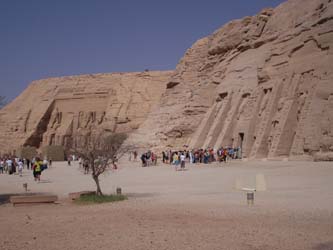
© Neil and Kathy Carey - Abu Simbel
Belzoni returned in 1817, with the English explorer and Egyptologist William John Bankes, and was able to reveal the entrance and to enter the base of the monument, taking every small item of value with him when he left.
Abu Simbel, however, was not the name given to the site during antiquity. Many believe that Abu Simbel was the name of a young local boy who had seen the buried temples through the shifting sands and guided Burckhardt to the site. Four years later, Belzoni excavated the area and named it after the boy who led Burckhardt. Unfortunately, whatever the ancient Egyptians named the complex has now been lost.
Relocation – A Massive Undertaking
Abu Simbel was originally constructed just 280 km outside Aswan, on the western bank of Lake Nasser. In the 1960s, the Egyptian government decided to build the Aswan High Dam on the Nile River, and it was feared that this would result in flooding Lake Nasser to such levels that the temples of Abu Simbel would be submerged.
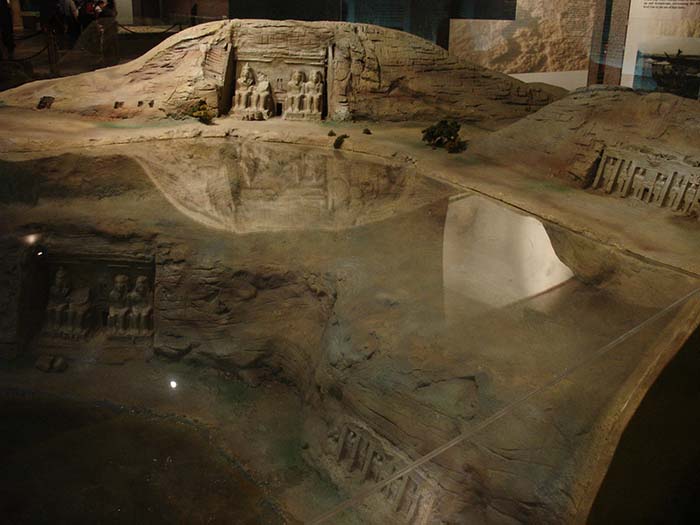
© Zureks - Abu Simbel Temples model, showing original and relocation site
From 1964-1968, UNESCO set forth an initiative to move both the Great Temple and the Small Temple to a plateau on the cliffs. The temples were dismantled, moved 60 meters up the sandstone cliff that they originally stood on and were then reassembled. Great efforts were made to reconstruct the two temples in the exact, original orientation they had held to each other and the sun. They were even built into a man-made mountain to give the original impression of being cut into a rock cliff.
Sun Festival
The Sun Festival is a biannual celebration that still takes place in Egypt today. It marks the highlight of the tourist season in Aswan. On February 22nd and October 22nd, when the sun illuminates the back wall, the statues there are washed in sunlight. Although the Great Temple is also dedicated to Ptah, god of the Underworld, Ptah remains appropriately hidden from the sun. The modern day Sun Festival begins right before sunrise. Musicians and dancers are gathered to celebrate not just Ramses II and Nefertari, but of the remarkable technological and astronomical prowess exhibited by the ancient Egyptians.
The Abu Simbel Temples Today
Near the re-erected temples now stands a man made dome, which houses an exhibit of photographs, detailing the entire relocation. Now one of Egypt’s most visited tourist attractions(complete with a sound and light show), this pair of temples have come to be called part of what is called the 'Nubian Monuments'.
Thousands of tourists visit these temples daily, arriving by plane via a field constructed near the temples, and by guarded convoys that depart twice daily from the nearest city of Aswan.
Abu Simbel – Quick Facts
- Abu Simbel is comprised of two temples, one dedicated to Ramses II and one to his chief wife, Nefertari. The Small Temple represents the second time an entire temple was dedicated to a royal wife. It demonstrated his great love for her.
- From 1964-1968, both temples were carefully carved into many pieces and relocated to a higher plateau to avoid being permanently submerged by the effects of the Aswan High Dam.
- The exquisite carvings, artwork and statues within the interior of both structures are so delicate, cameras are not allowed for fear of damage or fading.
- Abu Simbel has many depictions of Ramses II’s accomplishments, most of all his victory at the Battle of Kadesh.
- On the facade of the Small Temple, there are smaller statues of the children. Unusually, the princesses are depicted as taller than the princes. It is likely because the entire temple was dedicated not just to Nefertari, but to all of the women in Ramses II’s household.

